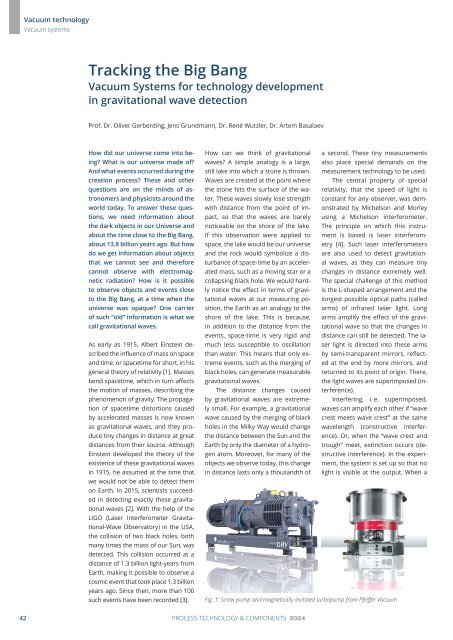PuK - Process Technology & Components 2024
A technical trade magazine with a history of more than 60 years.
A technical trade magazine with a history of more than 60 years.
Create successful ePaper yourself
Turn your PDF publications into a flip-book with our unique Google optimized e-Paper software.
Vacuum technology<br />
Vacuum systems<br />
Tracking the Big Bang<br />
Vacuum Systems for technology development<br />
in gravitational wave detection<br />
Prof. Dr. Oliver Gerberding, Jens Grundmann, Dr. René Wutzler, Dr. Artem Basalaev<br />
How did our universe come into being?<br />
What is our universe made of?<br />
And what events occurred during the<br />
creation process? These and other<br />
questions are on the minds of astronomers<br />
and physicists around the<br />
world today. To answer these questions,<br />
we need information about<br />
the dark objects in our Universe and<br />
about the time close to the Big Bang,<br />
about 13.8 billion years ago. But how<br />
do we get information about objects<br />
that we cannot see and therefore<br />
cannot observe with electromagnetic<br />
radiation? How is it possible<br />
to observe objects and events close<br />
to the Big Bang, at a time when the<br />
universe was opaque? One carrier<br />
of such “old” information is what we<br />
call gravitational waves.<br />
As early as 1915, Albert Einstein described<br />
the influence of mass on space<br />
and time, or spacetime for short, in his<br />
general theory of relati vity [1]. Masses<br />
bend spacetime, which in turn affects<br />
the motion of masses, describing the<br />
phenomenon of gravity. The propagation<br />
of spacetime distortions caused<br />
by accelerated masses is now known<br />
as gravitational waves, and they produce<br />
tiny changes in distance at great<br />
distances from their source. Although<br />
Einstein developed the theory of the<br />
existence of these gravitational waves<br />
in 1915, he assumed at the time that<br />
we would not be able to detect them<br />
on Earth. In 2015, scientists succeeded<br />
in detecting exactly these gravitational<br />
waves [2]. With the help of the<br />
LIGO (Laser Interferometer Gravitational-Wave<br />
Observatory) in the USA,<br />
the collision of two black holes, both<br />
many times the mass of our Sun, was<br />
detected. This collision occurred at a<br />
distance of 1.3 billion light-years from<br />
Earth, making it possible to observe a<br />
cosmic event that took place 1.3 billion<br />
years ago. Since then, more than 100<br />
such events have been recorded [3].<br />
How can we think of gravitational<br />
waves? A simple analogy is a large,<br />
still lake into which a stone is thrown.<br />
Waves are created at the point where<br />
the stone hits the surface of the water.<br />
These waves slowly lose strength<br />
with distance from the point of impact,<br />
so that the waves are barely<br />
noticeable on the shore of the lake.<br />
If this observation were applied to<br />
space, the lake would be our universe<br />
and the rock would symbolize a disturbance<br />
of space-time by an accelerated<br />
mass, such as a moving star or a<br />
collapsing black hole. We would hardly<br />
notice the effect in terms of gravitational<br />
waves at our measuring position,<br />
the Earth as an analogy to the<br />
shore of the lake. This is because,<br />
in addition to the distance from the<br />
events, space-time is very rigid and<br />
much less susceptible to oscillation<br />
than water. This means that only extreme<br />
events, such as the merging of<br />
black holes, can generate measurable<br />
gravitational waves.<br />
The distance changes caused<br />
by gravitational waves are extremely<br />
small. For example, a gravitational<br />
wave caused by the merging of black<br />
a second. These tiny measurements<br />
also place special demands on the<br />
measurement technology to be used.<br />
The central property of special<br />
relativity, that the speed of light is<br />
constant for any observer, was demonstrated<br />
by Michelson and Morley<br />
using a Michelson interferometer.<br />
The principle on which this instrument<br />
is based is laser interferometry<br />
[4]. Such laser interferometers<br />
are also used to detect gravitational<br />
waves, as they can measure tiny<br />
changes in distance extremely well.<br />
The special challenge of this method<br />
is the L-shaped arrangement and the<br />
longest possible optical paths (called<br />
arms) of infrared laser light. Long<br />
arms amplify the effect of the gravitational<br />
wave so that the changes in<br />
distance can still be detected. The laser<br />
light is directed into these arms<br />
by semi-transparent mirrors, reflected<br />
at the end by more mirrors, and<br />
returned to its point of origin. There,<br />
the light waves are superimposed (interference).<br />
Interfering, i. e. superimposed,<br />
waves can amplify each other if “wave<br />
crest meets wave crest” at the same<br />
holes in the Milky Way would change wavelength (constructive interference).<br />
the distance between the Sun and the<br />
Earth by only the diameter of a hydrogen<br />
atom. Moreover, for many of the<br />
objects we observe today, this change<br />
in distance lasts only a thousandth of<br />
Or, when the “wave crest and<br />
trough” meet, extinction occurs (destructive<br />
interference). In the experiment,<br />
the system is set up so that no<br />
light is visible at the output. When a<br />
Fig. 1: Screw pump and magnetically levitated turbopump from Pfeiffer Vacuum<br />
42 PROCESS TECHNOLOGY & COMPONENTS <strong>2024</strong>

















